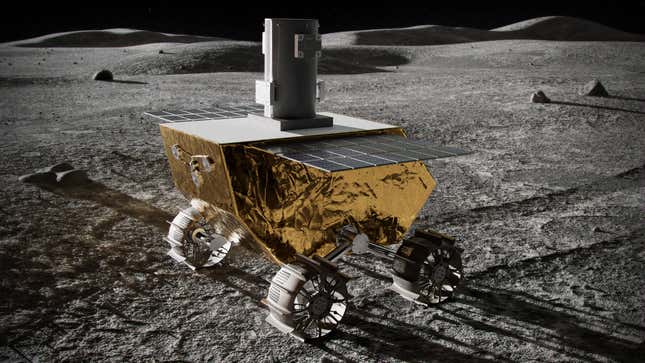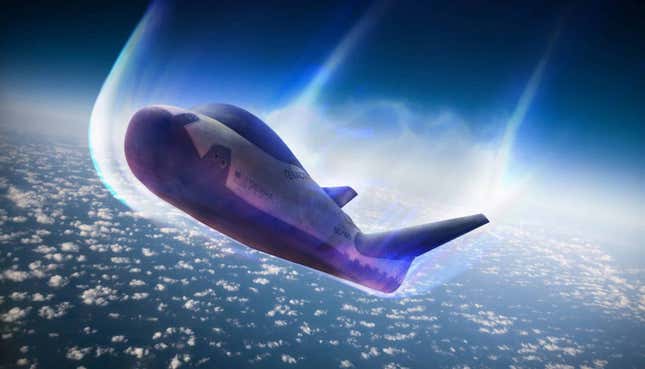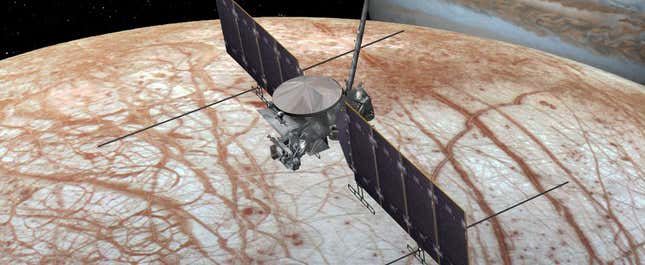A Martian moons mission, a plethora of private lunar landers, probes to Venus and Jupiter, and reusable heavy-lift rocket tests are among the many highlights we’ll be watching in the coming 12 months, in what looks to be an extraordinary year in spaceflight. Here’s your 2024 calendar.
The Moon takes center stage in 2024
An unprecedented number of missions to the Moon, both private and public, are set to take place in the coming year, capped by NASA’s crewed Artemis 2 mission around our natural satellite. Before that happens, however, there’s a trove of robotic missions we can look forward to.
Advertisement
Three Intuitive Machines lunar missions
The Intuitive Machines 1 mission (IM-1), scheduled for launch on January 12, 2024, is designed to place the Nova-C lander at crater Malapert A near the Moon’s south pole. This mission is notable for being a commercially built lunar lander, carrying a suite of NASA payloads in addition to commercial cargo. These payloads are part of NASA’s Commercial Lunar Payload Services (CLPS) program.
Advertisement

The Nova-C lander will carry five NASA-sponsored instruments along with payloads from other customers, including EagleCAM (which will detach from the lander during the descent and capture the moment Nova-C reaches the surface). The lander is expected to operate for one lunar day, roughly equivalent to about 14 Earth days. The lander should be able to perform a decent amount of exploration and data gathering during this period.
Advertisement
The U.S. company is expecting to launch three lunar missions next year, all sent to space aboard a SpaceX Falcon 9 rocket. In addition to Intuitive Machines’ IM-1, there’s IM-2, which could go up in early 2024; this second mission aims to place the Nova-C lander near Shackleton Crater at the Moon’s south polar region to demonstrate on-site resource utilization and measure volatile content using a regolith and ice drill, called TRIDENT. This is in addition to delivering a mass spectrometer, a 4G internet experiment for Nokia, and a lunar rover engraved with a crypto wallet passcode. This mission will also see the launch of NASA’s Lunar trailblazer, an orbiter designed to detect, map, and study the Moon’s water from lunar orbit.

Advertisement
A third Intuitive Machines mission, planned for mid-2024 and called IM-3, is expected to deliver multiple payloads to the Moon’s Reiner Gamma region, including four NASA payloads and the Lunar Vertex rover, to conduct scientific investigations and demonstrate advanced technologies for future lunar exploration.
Astrobotic’s Peregrine Lunar Lander
The month of January could in fact see two private landers reach the Moon’s surface, the other being Astrobotic’s Peregrine Mission 1 (TO2-AB). It’s scheduled to launch aboard ULA’s Vulcan Centaur on December 24, 2023, and attempt a lunar landing at Sinus Viscositatis 32 days later. The mission involves the U.S. company’s Astrobotic’s Peregrine Lunar Lander, which was selected through NASA’s CLPS program. The lander’s many payloads include the Laser Retroreflector Array for precision distance measurements and the Neutron Spectrometer System for regolith composition analysis.
Advertisement
JAXA’s SLIM Moon mission
If that’s not enough lunar action for you in January, there’s yet a third Moon landing attempt planned (yes, a third!) in the first month of year, this one a public lander operated by Japan. Its space agency, JAXA, plans to make history with the first-ever soft lunar landing of a Japanese spacecraft, SLIM (Smart Lander for Investigating Moon), targeted for January 19. Launched on September 6, 2023, alongside the XRISM space telescope, SLIM is designed for a pinpoint landing within 330 feet (100 meters) of its target destination, a feat unprecedented in lunar exploration. Should it succeed, Japan will become just the fifth nation to successfully land a probe on the Moon. This mission, showcasing advanced landing technology, is meant to pave the way for more ambitious missions. SLIM, measuring 8.8 feet long, also carries two miniprobes for on-site photography and communications.
Advertisement
Astrobotic’s Griffin Mission 1
In addition to the January landing, Astrobotic has plans for a second trip to the Moon in 2024, an endeavor known as Griffin Mission 1. Slated for launch on board a SpaceX Falcon Heavy rocket in November, and also done in conjunction with NASA’s CLPS, the mission will see NASA’s VIPER rover land on the Moon’s southern polar region aboard Astrobotic’s Griffin lander. Similar in size to a golf cart, VIPER will explore the region near Nobile crater for 100 days, analyzing regolith for water ice and other volatiles using a drill and spectrometer.
Related article: NASA Chose a Really Sweet Spot to Land Its Upcoming Lunar Rover
The mission aims to understand lunar water distribution and potential resource utilization for future exploration. Equipped with solar panels and X-band communication, VIPER is expected to travel from 10 to 15 miles (16 to 24 kilometers), showcasing technologies for extreme lunar environments.
Advertisement
China’s Chang’e-6 mission
China’s Chang’e-6 mission, with a potential launch in May 2024, aims to make history by collecting the first lunar samples from the far side of the Moon. Targeting the Apollo crater within the massive South Pole-Aitken basin, the mission will employ a relay satellite for communication and carry out complex operations including landing, scooping, and drilling to collect samples. Additionally, it will host international payloads like France’s DORN instrument to study radon outgassing, Sweden’s NILS for detecting negative lunar surface ions, and Pakistan’s ICECUBE-Q cubesat. This ambitious mission, launching aboard a Long March 5 rocket, follows the success of Chang’e-5, China’s first lunar sample return mission.
Advertisement
Firefly Aerospace’s Blue Ghost Mission 1

Advertisement
Firefly Aerospace’s Blue Ghost Mission 1, set for launch during the latter half of 2024, will deliver a diverse set of payloads—including 10 NASA-sponsored ones—to the Moon as part of the CLPS initiative. The Texas company’s Blue Ghost lander will touch down in Mare Crisium to study lunar regolith and the Moon’s unique geophysical characteristics. This mission, launching aboard a Falcon 9, aims to advance lunar research and support future human missions, with demonstrations like regolith sampling and lunar dust mitigation. The data gathered will enhance lunar knowledge and provide insights into space weather effects on Earth.
NASA’s Artemis 2 mission
It’s not just robots headed to the Moon. The much-anticipated Artemis 2 mission could happen as early as November. This is the sequel to 2022’s Artemis 1, in which NASA’s Space Launch System megarocket launched for the very first time, sending an uncrewed Orion capsule on a journey around the Moon. For this second mission, four astronauts will be on board: NASA’s Reid Wiseman, Victor Glover, and Christina Koch, along with Canadian Space Agency Astronaut Jeremy Hansen.
Advertisement

It’ll mark the first time since the Apollo era that humans will travel to the lunar environment, setting the stage for Artemis 3—a crewed landing onto the surface. To get Artemis 2 off the ground on schedule, the SLS rocket needs to be fully assembled and verified. Plus, NASA is studying Orion’s heat shield to determine why it exhibited unexpected degradations during re-entry at the conclusion of Artemis 1.
Advertisement
ispace Hakuto-R Mission 2
The Hakuto-R Mission 2, slated for late 2024, represents ispace’s second lunar landing attempt, building on lessons from the failed Mission 1; the company’s lunar lander crashed onto the lunar surface in April 2023 while attempting a soft landing. A key goal of the mission is to deploy a micro rover, engineered to endure the Moon’s harsh conditions. Equipped with a high-definition camera, the rover will attempt to collect lunar dust, which NASA will then purchase from the company as part of the Artemis program. Mission 2 incorporates improvements in software, landing simulation, and sensor testing to avoid Mission 1’s landing failure. It will carry five payloads, including scientific equipment and a commemorative plate. Manufacturing and assembly are underway in Japan, with a planned Falcon 9 launch.
Advertisement
Exciting new rockets and spacecraft
The vehicles that take us to orbit and beyond are getting more advanced and more diverse. This year will see a slate of fresh tests and inaugural launches.
Advertisement
Sierra Space’s Dream Chaser spaceplane
Dream Chaser, a Space Shuttle-like spaceplane being developed by Colorado-based Sierra Space, could finally fly in 2024. Featuring wings and a lifting body design, Dream Chaser will launch aboard a rocket but land on conventional runways.
Advertisement

The spacecraft will primarily be used for transporting supplies to the International Space Station (ISS), but it also has potential for other missions such as satellite deployments and scientific research. Final tests at NASA are pending, but should everything look good, Dream Chaser will launch in April during the second flight of ULA’s Vulcan Centaur rocket on an uncrewed mission to the ISS.
Advertisement
Boeing CST-Starliner
Years behind schedule, a Boeing CST-Starliner capsule—with an actual crew onboard—is also scheduled to fly in April. NASA’s Boeing Crew Flight Test (CFT) aims to test the Starliner spacecraft by sending it, along with astronauts Butch Wilmore and Suni Williams, to the ISS. The purpose of this flight is to demonstrate Starliner’s operational capabilities and confirm its suitability for future crewed orbital missions. The mission will employ a ULA Atlas V rocket for liftoff from Cape Canaveral Space Force Station in Florida, with the spacecraft expected to remain docked at the ISS for about eight days.
Advertisement

Ariane 6 first launch
Europe’s next-gen rocket, Ariane 6, is slated to launch for the first time at some point between June 15 and July 31. A recent launch rehearsal went well, but more tests are pending ahead of its maiden voyage. With the retirement of Ariane 5, the two variants of Ariane 6 are now central to Europe’s space ambitions, crucial for maintaining the continent’s independent access to space.
Advertisement
Blue Origin’s New Glenn rocket
Blue Origin, founded by Amazon billionaire Jeff Bezos, has yet to send a rocket to Earth orbit (its New Shepard space tourism rocket is suborbital), but that could change in 2024, as the company’s New Glenn rocket could fly as early as August. New Glenn is important for Blue Origin mainly because it marks a significant step up in its capabilities. It’s a heavy-lift rocket that can send bigger payloads into orbit, enabling Blue Origin to get into the competitive space launch market and square up against big names like SpaceX.
Advertisement
India’s Gaganyaan and Vikram-1
In 2024, India’s Gaganyaan mission, aimed at pioneering the nation’s human spaceflight capabilities, is set to achieve some significant milestones. Managed by the Indian Space Research Organization (ISRO), the first of at least two missions in the year will begin with a test flight to an altitude of 9.3 miles (15 km), focusing on abort simulation procedures. This will be followed by a second test flight, deploying Vyommitra, a female-looking humanoid robot, to validate systems at a higher altitude. These tests should pave the way for the mission’s pinnacle event: India’s first crewed spaceflight, which could happen in late 2024, or more likely in 2025.
Advertisement
India’s space sector is set to achieve a significant milestone with the inaugural flight of the Vikram-1 rocket, developed by Hyderabad-based startup Skyroot Aerospace. This mission, a further sign of India’s rapid advancement in private space exploration, is notable for its carbon fiber structure and 3D-printed liquid engines. Vikram-1, a multi-stage launch vehicle with a capacity to carry payloads of around 660 pounds (300 kilograms) into lower Earth orbit, stands to boost Skyroot’s role in the industry and directly challenge ISRO’s SSLV rocket.
A bunch of cool happenings in deep space
Several science missions to other planets and moons in our solar system will capture our imaginations in 2024, collecting images and data that will drive discoveries for many years to come.
Advertisement
Mars EscaPADE mission
If and when New Glenn launches next year, it is set to transport two Photon spacecraft, embarking on a mission to study Mars’ magnetosphere. Called EscaPADE, the mission is part of NASA’s Small Innovative Missions for Planetary Exploration (SIMPLEx) program, and its in-orbit explorations of Mars could help to explain why the Martian atmosphere is so leaky.
Advertisement

Jupiter Icy Moons Explorer (JUICE) mission
The Jupiter Icy Moons Explorer (JUICE) mission, operated by the European Space Agency (ESA), is set to perform its first Earth-Moon gravitational assist in August 2024. This sequence is crucial for maximizing the effectiveness of the gravity assist, enabling JUICE to achieve the correct trajectory, speed, and direction for its mission.
Advertisement
Bepi-Colombo at Mercury
On September 5, the European Space Agency’s Bepi-Colombo will perform its fourth Mercury flyby, a crucial maneuver in its mission to study the planet in detail. This flyby will allow the spacecraft to adjust its trajectory and gather valuable data, contributing to our understanding of this hot and enigmatic planet.
Advertisement
Japan’s Martian Moons Exploration (MMX) mission
The Martian Moons Exploration (MMX) mission, led by the Japanese Aerospace Exploration Agency (JAXA), is a robotic space probe scheduled for launch in September 2024. Its primary objective is to collect and return the first samples from Phobos, the largest moon of Mars. The MMX mission is crucial as it seeks to uncover whether Mars’ moons, Phobos and Deimos, originated from captured asteroids or a massive impact on Mars—insights that could enhance our understanding of the Martian system and the formation of celestial bodies in our solar system.
Advertisement

NASA’s Europa Clipper mission
Set to launch in October, NASA’s Europa Clipper, which aims to investigate Jupiter’s moon Europa for potential signs of life, will embark on its journey aboard a Falcon Heavy rocket. Europa is intriguing because it’s believed to host a subsurface ocean beneath its icy crust, which might be hospitable to life. The spacecraft, built to withstand intense radiation, will enter a wide orbit around Jupiter in 2030. This path allows it to swoop in close to Europa repeatedly, gathering detailed data on this potentially life-supporting moon.
Advertisement
Hera asteroid mission
ESA’s Hera mission to re-visit the asteroid Didymos and its moon Dimorphos is set to blast off in October. This marks the ongoing phase of NASA’s Double Asteroid Redirection Test (DART), which aims to assess the feasibility of altering asteroid trajectories by colliding spacecraft, called kinetic impactors, directly with them. Arriving at the binary system in December 2026, Hera will perform an on-site inspection to evaluate the effects of the DART experiment, which slammed into Dimorphos on September 26, 2022.
Advertisement
Rocket Lab’s Venus Life Finder mission
The Venus Life Finder mission, a collaboration between Rocket Lab and MIT, is a pioneering private mission to Venus, launching no earlier than December 2024. This mission will send a small probe, equipped with a single science instrument, to analyze organic molecules and potential signs of life in the Venusian atmosphere. Launched aboard Rocket Lab’s Electron rocket, the probe will use a lunar gravity assist to reach Venus by 2025, descending through the planet’s potentially habitable cloud layer.
Advertisement
Low Earth orbit happenings
Much of this year’s action will take place close to home, in low Earth orbit.
Axiom Space Mission 3 (Ax-3)
Axiom Mission 3 (Ax-3), scheduled for launch no earlier than January 2024, represents another important step for the company and private spaceflight in general. Operated by Axiom Space and utilizing a SpaceX Falcon 9 rocket and Crew Dragon spacecraft, the mission will launch from NASA’s Kennedy Space Center in Florida, carrying the first all-European crew to the ISS. The crew, including Commander Michael López-Alegría and Pilot Walter Villadei, will embark on a 14-day mission focused on conducting pioneering microgravity research. Axiom plans to return to the ISS in October, with Axiom Mission 4 (Ax-4), for another two-week stint. These missions showcase the increasing teamwork between private space firms and government space agencies, illustrating the dynamic changes happening in the realm of global space exploration.
Advertisement
SpaceX Starlink satellites and Starship rocket
In addition to the aforementioned projects involving SpaceX, the Elon Musk-led company will continue to deposit its Starlink internet satellites in low Earth orbit throughout the year. The company will also continue to develop its Starship megarocket, and we can expect multiple demo missions of the two-stage launch vehicle in 2024. Should all go well for SpaceX, the Starship second stage might even reach orbit in the coming months and attempt reentry.
Advertisement
Amazon Project Kuiper satellites
Amazon’s Project Kuiper, a satellite internet initiative similar to SpaceX’s Starlink, will get off the ground in earnest next year. The company is gearing up to begin satellite production in anticipation of a large-scale deployment set to start in early 2024, with plans to have sufficient satellites in orbit to start preliminary customer trials in the latter half of 2024.
Advertisement
Phew! That’s a lot, and this is just a partial list—lots of smaller missions are also planned in 2024. We’ll be there each step of the way to chronicle these missions, in what looks to be another remarkable year in space.
For more spaceflight in your life, follow us on X (formerly Twitter) and bookmark Gizmodo’s dedicated Spaceflight page.
Services Marketplace – Listings, Bookings & Reviews